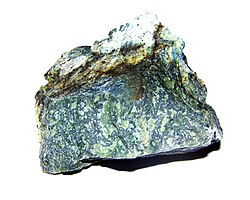| Nephrite | |
|---|---|
 Nephrite from Jordanów Śląski (Poland) | |
| General | |
| Category | Inosilicate |
| Formula | Ca2(Mg,Fe)5Si8O22(OH)2 [1] |
| Crystal system | monoclinic [1] |
| Identification | |
| Color | Translucent to opaque and often mottled. Light to dark green, yellow to brown, white, gray, black. [1] |
| Crystal habit | massive [1] |
| Fracture | splintery to granular [1] |
| Mohs scale hardness | 6.0 to 6.5 [1] |
| Luster | dull [1] |
| Specific gravity | 2.95+0.15 −0.05 [1] |
| Polish luster | vitreous to greasy [1] |
| Optical properties | Double refractive with anomalous aggregate reaction [1] |
| Refractive index | 1.606 to 1.632+0.009 −0.006 [1] |
| Birefringence | usually not detectable [1] |
| Pleochroism | none [1] |
| Ultraviolet fluorescence | inert [1] |
| Absorption spectra | Vague line may be present at 500 nm, but rarely any lines. Rarely, in stones of exceptional gem quality, vague lines in the red part of the spectrum may be seen. [1] |
Nephrite is a variety of the calcium, magnesium, and iron-rich amphibole minerals tremolite or actinolite (aggregates of which also make up one form of asbestos). The chemical formula for nephrite is Ca 2(Mg, Fe)5 Si 8 O 22(OH)2. [1] It is one of two different mineral species called jade. The other mineral species known as jade is jadeite, which is a variety of pyroxene. While nephrite jade possesses mainly grays and greens (and occasionally yellows, browns, black or whites), jadeite jade, which is rarer, can also contain blacks, reds, pinks and violets. Nephrite jade is an ornamental stone used in carvings, beads, or cabochon cut gemstones. Nephrite is also the official state mineral of Wyoming.
Contents
- Name
- Other names
- History
- Neolithic and Chalcolithic Europe
- Prehistoric and historic China
- Prehistoric Taiwan and Southeast Asia
- Māori
- References
- General references
- Inline citations
- Further reading
- External links
Nephrite can be found in a translucent white to very light yellow form which is known in China as mutton fat jade, in an opaque white to very light brown or gray which is known as chicken bone jade, [1] as well as in a variety of green colors. Western Canada is the principal source of modern lapidary nephrite. [2] Nephrite jade was used mostly in pre-1800 China as well as in New Zealand, the Pacific Coast and Atlantic Coasts of North America, Neolithic Europe, and southeast Asia.


